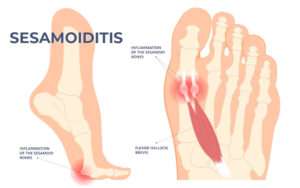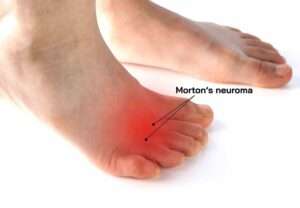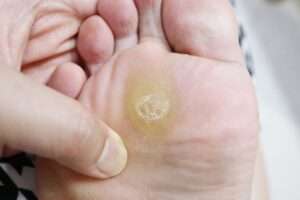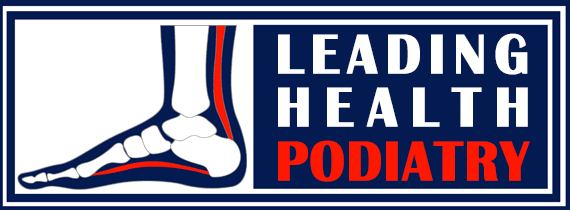Forefoot Pain
- Forefoot pain, commonly referred to as pain in the ball of the foot, is a condition we see frequently at Leading Health Podiatry. The forefoot consists of 21 small bones, muscles, ligaments, tendons, nerves, blood vessels, and other tissues, making pain in this area complex to diagnose. With our expertise in podiatric care, we understand the importance of accurate diagnosis and treatment, ensuring that the best course of action is taken to alleviate pain and restore mobility.
What Causes Forefoot Pain?
Several conditions can lead to forefoot pain, and a comprehensive evaluation is essential to determine the exact cause. This process includes a thorough history, gait analysis, and clinical testing. Some of the most common causes of forefoot pain include:
- Sesamoiditis
Sesamoiditis occurs when the small sesamoid bones beneath the big toe become inflamed or irritated due to excess pressure or overuse. These bones, embedded in tendons, can cause significant pain when affected.

- Bursitis
Bursae are fluid-filled sacs that cushion tendons and bones. When they become irritated, they can swell, leading to bursitis, which causes pain and discomfort in the forefoot. - Morton’s Neuroma
A Morton’s neuroma is an enlargement of the nerve sheath between the metatarsal bones of the foot. It is most common between the third and fourth toes and can cause burning, tingling, numbness, or sharp pain when the toes are compressed.

- Capsulitis or Synovitis
Capsulitis is inflammation of the joint capsule, while synovitis refers to inflammation of the synovium (lining of the joint capsule). These conditions are often caused by repetitive stress, such as during running or high-impact activities. - Plantar Plate Injury
The plantar plate is a fibrous ligament that helps stabilize the metatarsal heads. Injury or tears to this ligament can lead to pain and swelling in the ball of the foot, sometimes accompanied by a noticeable gap between affected toes - Hammertoes or Claw Toes
Hammertoes and claw toes are deformities where the toes become permanently bent due to tight footwear or repeated toe gripping for stability, causing pain and discomfort.
Pain from Arthritis
Arthritis, including osteoarthritis, rheumatoid arthritis, and gout, can affect the joints in the foot, leading to pain, stiffness, and swelling. Over time, this can result in joint degeneration and worsening symptoms.Corns or Calluses
Corns and calluses form as a response to excessive pressure or friction in certain areas of the foot. When these build up on weight-bearing areas, they can cause sharp pain, making walking difficult.

How is Forefoot Pain Treated?
At Leading Health Podiatry, we provide individualized treatment plans tailored to the specific condition causing forefoot pain. After a thorough examination and accurate diagnosis, management strategies may include:
Custom Foot Orthotics
Custom foot orthotics can help offload pressure from the affected area, providing relief and promoting better foot function.Immobilisation
In cases of severe pain or acute symptoms, a short leg pneumatic walker or boot may be used to immobilize the foot and allow the injury to heal.Strengthening and Stretching Exercises
When muscles surrounding the injury are involved, specific exercises to strengthen and stretch these muscles can be beneficial for restoring full function.Footwear Modifications
Modifying footwear with a forefoot rocker or cushion can reduce pressure on the painful area and improve overall comfort, helping to manage forefoot pain.
If you are suffering from forefoot pain, contact Leading Health Podiatry today to schedule an appointment. Our team is here to help you find the right solution to get you back on your feet pain-free.
